July Payrolls Smash Expectations Soaring To 528K, Wages Come In Red Hot As Unemployment Rate Drops
We are now well and truly in bizarro world.
In a time when the US is in a technical recession, and when tech companies are mass laying off thousands of people, moments ago the BLS reported that in July the US added a whopping 528K jobs, more than double the 250K expected, up solidly from last month’s upward revised 398K (up from 372K) and the highest since February’s 714K!
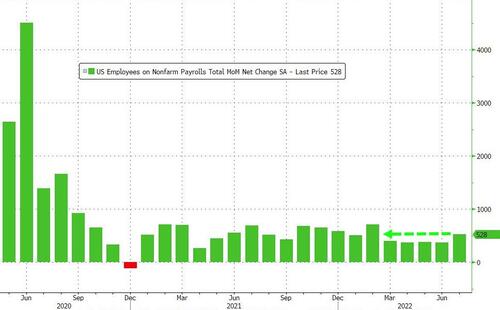
Today’s number means total nonfarm employment has increased by 22.0 million since reaching a low in April 2020 and is back to pre-pandemic levels. Private-sector employment is 629,000 higher than in February 2020, although several sectors have yet to recover. Government employment is 597,000 lower than its pre-pandemic level.
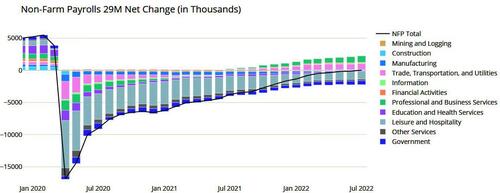
Just how ridiculous was the last monthly cooking of the books by the BLS? So ridiculous that the reported number was a 6 sigma beat to expectations:
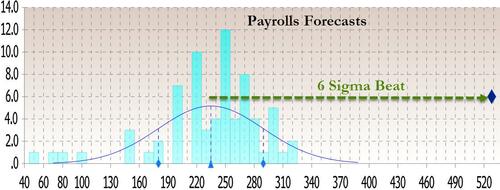
One caveat: for the 4th month in a row, the household survey came in far worse than the Establishment survey, and showed a far more modest gain in July employment, at just 179,000 jobs created – notably fewer than the payroll report, but a lot stronger than the 315,000 drop for June.
Reading between the lines, there was 471,000 new private payroll jobs added, more than double the 230k estimates. Not surprisingly, the bulk of new jobs came from the service sector.

But not only did July blow away expectations, but both previous months were revised higher: the change in total nonfarm payroll employment for May was revised up by 2,000, from +384,000 to +386,000, and the change for June was revised up by 26,000, from +372,000 to +398,000. With these revisions, employment in May and June combined is 28,000 higher than previously reported.
The unemployment rate also declined, sliding to 3.5%, from 3.6%, and below the 3.6% estimate as the number of unemployed persons edged down to 5.7 million. These measures have returned to their levels in February 2020, prior to the coronavirus pandemic.
Among the major worker groups, the unemployment rates for adult women (3.1 percent) and Whites (3.1 percent) declined in July. The jobless rates for adult men (3.2 percent), teenagers (11.5 percent), Blacks (6.0 percent), Asians (2.6 percent), and Hispanics (3.9 percent) showed little change over the month.
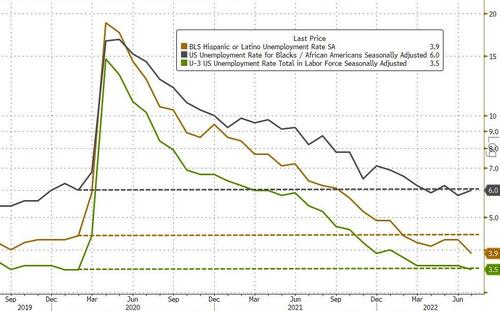
The participation rate declined again from 62.2% to 62.1%, as the number of people in the job market — either working or looking for work — declined again last month. What the Fed really wants is to see people flocking back in, driving up the unemployment rate and easing pressure on wages. Instead what we are seeing is people leaving the job market and employers fighting to grab those that remain, luring them with higher wages.

It wasn’t just payrolls that smashed expectations however, as wages also came in red hot: July Average Hourly Earnings rose 5.2% Y/Y, smashing expectations of 4.9% and increased 0.5% M/M; also beating estimates of 0.3%.
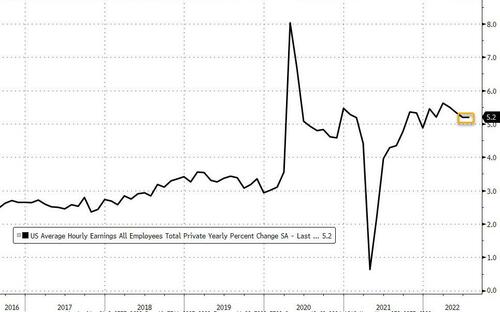
Additionally, the Average workweek was 34.6 hours the fifth month in a row, beating expectations of a decline to 34.5. In manufacturing, the average workweek for all employees held at 40.4 hours, and overtime increased by 0.1 hour to 3.3 hours. The average workweek for production and nonsupervisory employees on private nonfarm payrolls remained unchanged at 34.0 hours.
That said, once again there was a stark divergence between the Establishment (+528K) and the Household Survey (+179K). In fact, as shown below, according to the Household survey there has been no jobs growth since March, while according to the Establishment survey the US has added 700K jobs!
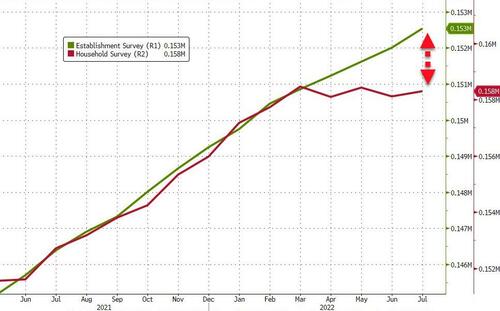
Digging deeper into the report, we find the following:
- In July, 7.1 percent of employed persons teleworked because of the coronavirus pandemic, unchanged from the prior month. These data refer to employed persons who teleworked or worked at home for pay at some point in the 4 weeks preceding the survey specifically because of the pandemic.
- In July, 2.2 million persons reported that they had been unable to work because their employer closed or lost business due to the pandemic–that is, they did not work at all or worked fewer hours at some point in the 4 weeks preceding the survey due to the pandemic.
- Among those not in the labor force in July, 548,000 persons were prevented from looking for work due to the pandemic, little changed from the prior month.
Looking at jobs broken down by sector we find the following:
- Employment in leisure and hospitality added 96,000 jobs, as growth continued in food services and drinking places (+74,000).
- Employment in professional and business services continued to grow, with an increase of 89,000 in July. Job growth was widespread within the industry, including gains in management of companies and enterprises (+13,000), architectural and engineering services (+13,000), management and technical consulting services (+12,000), and scientific research and development services (+10,000).
- Employment in health care rose by 70,000 in July. Job gains occurred in ambulatory health care services (+47,000), hospitals (+13,000), and nursing and residential care facilities (+9,000).
- Employment in government rose by 57,000 in July but is below its February 2020 level by 597,000, or 2.6 percent. Over the month, employment increased by 37,000 in local government, mostly in education (+27,000).
- Employment in construction increased by 32,000 in July, as specialty trade contractors added 22,000 jobs.
- Manufacturing employment increased by 30,000 in July. Employment in durable goods industries rose by 21,000, with job gains in semiconductors and electronic components (+4,000) and miscellaneous durable goods manufacturing (+4,000).
- In July, social assistance added 27,000 jobs, including a gain of 19,000 in individual and family services.
- Employment in retail trade increased by 22,000 in July, although it has shown no net change since March. In July, job gains occurred in food and beverage stores (+9,000) and general merchandise stores (+8,000). Retail trade employment is 208,000 above its level in February 2020.
- Employment in transportation and warehousing added 21,000 jobs. Employment rose in air transportation (+7,000) and support activities for transportation (+6,000).
- Information employment continued its upward trend in July (+13,000) and is 117,000 higher than in February 2020.
- Employment in financial activities continued to trend up in July (+13,000).
- Employment in mining rose by 7,000 in July, with gains in support activities for mining (+4,000) and oil and gas extraction (+2,000).
Commenting on the report, Bloomberg Intelligence Chief Rates Strategist Ira Jersey, said “It’s hard to see how the yield curve doesn’t invert further as market will have to re-evaluate the Fed’s reaction to a labor market being as strong as it is. Regardless of a 50 vs. 75 in September, we think the market has to increase the terminal rate more than is priced, up to over 4% at least.”
Bloomberg commentator Ven Ram echoed the sentiment, writing that “this is a phenomenally strong jobs report, way stronger than forecast and more than the average payrolls expansion for the year through June. This will increase chatter for a 75-bp move from the Fed, and the reaction should be along those lines.”
Finally, Bloomberg Economics’ US Chief Economist Anna Wong said “the July jobs report settles it — we are not in a recession. More importantly, it also means the Fed will likely have to hike by another 75 basis points in September. Hiring was broad-based across sectors, and there was no evidence of widespread layoffs. The labor market has tightened even further from a high starting point. If there was any question of a dovish Fed pivot, this report has quashed it.”
Needless to say, and as we previewed, this jobs number which came in well above all sellside expectations, will surely boost expectations for a 75 basis point rate hike at the Fed’s September meeting, because as Bloomberg notes, “this is not at all what the Fed wanted to see. The job market if anything is getting even hotter, not cooling“, while John Brady at RJ O’Brien said:
“the market is going to price in a more aggressive Fed, only raising the odds of a hard landing somewhere down the road.”
The only thing that could reverse the narrative is if next week’s CPI print comes in far below expectations.
[ad_2]
Source link


